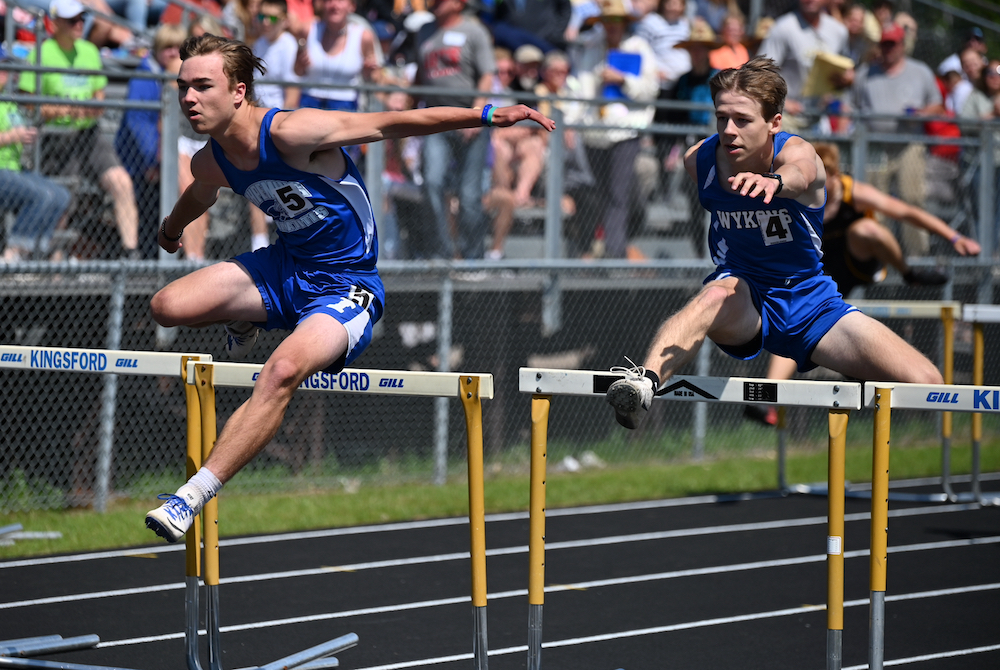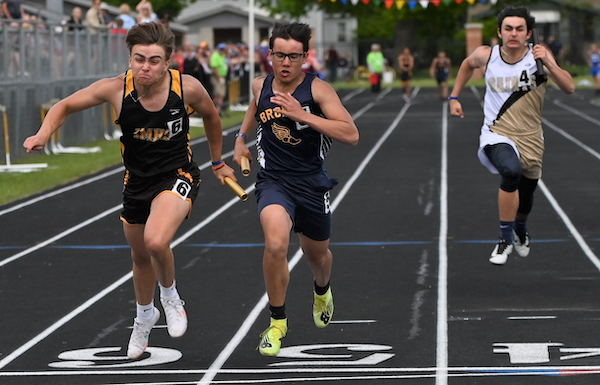
Ishpeming Adds to Near-Decade Reign Atop Upper Peninsula Division 2
By
John Vrancic
Special for MHSAA.com
June 5, 2022
KINGSFORD — The Ishpeming boys have allowed very little to stand between them and the Upper Peninsula Division 2 track & field championship in recent years.
They added another trophy to their collection Saturday by scoring 116 points.
The Hematites, who won three of the last four titles outright and shared the fourth, were followed by Iron Mountain with 102 points and St. Ignace at 63.
Senior Jonny Matson scored 36 points for the Hematites, who also have either won or tied for the title six of the last seven seasons.
That string was interrupted only in 2017 when they were runners-up to Newberry and three years later by COVID-19.
Last year, the Hematites shared the title with Norway.
Matson won the 400-meter dash in 53.58 seconds and long jump at 18 feet, 11¾ inches and was runner-up in the 100 (11.73) and 200 (23.77).
“Jon has been a great leader for us, and Parker Gauthier and Hunter Smith picked it up,” said Troy Smith, who shares Ishpeming’s coaching duties with his wife Trisha. “We greatly appreciate the effort of our coaching staff (Morgan Kangas, Khora Swanson and Hailey Smith). They’re a big part of our success.
“Our numbers have been a little low, but we have a great group of kids.”
 The Hematites won the 3,200-meter relay in 9 minutes, 4.42 seconds, and Tramon Gauthier added a first in the 110 hurdles (16.67) and second in the 300s (43.0).
The Hematites won the 3,200-meter relay in 9 minutes, 4.42 seconds, and Tramon Gauthier added a first in the 110 hurdles (16.67) and second in the 300s (43.0).
Smith was runner-up in high jump (5-11), and Parker Gauthier placed third in the 3,200 (11:44.6).
Iron Mountain’s Matt Colavechhi won the 100 (11.56) and 200 (23.71), and senior Luke Ruble added victories in the 1,600 (4:54.69) and 3,200 (10:52.05).
The Mountaineers also won the 400 relay (45.31) and 800 (1:34.42).
Bark River-Harris was runner-up in the 400 in a school-record 45.34
“Nick (Anderson) started real good and got us in a good spot,” said BR-H junior Vincent Martin, who ran the second leg. “We were seeded fourth. We knew the other three teams were good in the first and anchor legs. We mixed up our lineup a little and were in first going into the third leg.”
St. Ignace got a first from junior Reese McLean in the 800 (2:09.06), and Owen Lester took pole vault (10-0).
“That was a PR by three seconds,” said McLean. ‘With this being the last meet, I decided I might as well put everything into it. I think I started out all right. I wanted to get to the front right away.”
West Iron County’s Landon Sundelius won the 300 hurdles (40.56) and placed second in the 110s (16.74), and Nathan Hochstein of L’Anse was high jump champion at 5-11.
Manistique earned a victory in the 1,600 relay (3:43.99).
PHOTOS (Top) Ishpeming's Tramon Gauthier leads West Iron County's Landon Sundelius and they take first and second in the 110 hurdles. (Middle) Iron Mountain's Matthew Colavecchi edges Bark River-Harris's Vincent Martin by three hundredths of a second to seal the win in the 400 relay. Other members of Iron Mountain's winning relay were Max Jayne, Joey Colavecchi, and Kurt Adiano Ryan. (Click for more from Cara Kamps/Run Michigan.)

Track Gaining Speed Toward Future with Electronic Starting Devices
By
Steve Vedder
Special for MHSAA.com
May 23, 2023
Aubrey Greenfield thinks it might be the perfect time to reevaluate 130 years of tradition.
For a number of reasons, from technical to personal, the Oxford senior sprinter believes it makes sense for the crack of a starting pistol to be eliminated from high school track meets.
Because track meets would benefit in various ways from lowering costs to easier setup at meets to the human factor of competitors not having to flinch at the crack of a pistol shot, Greenfield believes the sport has a chance to embrace new technology – electronic starting devices (ESD).
In essence, an ESD replaces the starting pistol with a light flash, tone sound or both to begin a race.
"High school sports should put the athlete first," Greenfield said. "We should promote sports, and eliminating starting pistols promotes health in terms of PTSD or trauma for athletes and spectators and that would be good. I would like to think people would say that's a good idea."
In fact, Greenfield would go as far as to say if there was not an implementation of electronic starting devices, many of her teammates would have considered giving up the sport.
"If it's something that helps us compete safely, we're all for it," she said.
Greenfield's opinion apparently is spreading. Michigan High School Athletic Association senior assistant director Cody Inglis said the use of ESD makes it both affordable for meet starters and sensible for athletes and fans to rethink the use of starting pistols. While the MHSAA is not mandating electronic starting devices, it does promote the use of what Inglis calls "emerging technology." He notes that ESD are becoming the norm for organizations such as USA Track & Field, the NCAA and an increasing number of high schools.
 "I think we have to embrace new technology, and we think this will be something that takes hold," Inglis said.
"I think we have to embrace new technology, and we think this will be something that takes hold," Inglis said.
A key part of embracing ESD is the human element. The tragic Oxford High School shooting Nov. 30, 2021, that took the lives of four students while injuring seven others should not be relived even for a fleeting instance at a high school sporting event. Oxford athletic director Tony DeMare said the school began using ESD at every meet, including the MHSAA Lower Peninsula Division 1 Finals last June. He said that decision was embraced by virtually all schools Oxford encountered.
"We were very convinced that the alternative (of ESD) would promote a healthy attitude," DeMare said. "We were overwhelmed with the positive response. If a school was on the fence about it or might not be for it, I think we've started to see the tide turn in favor of people willing to listen and learn about electronic starting devices."
Inglis said the MHSAA is acutely aware of what the crack of a starting pistol can mean to athletes and fans.
"It's unimaginable what Oxford went through, and this is a small way we can help," he said. "We look at a (starting pistol) and think, ‘Could we do something else?’ It's a way of helping to solve a problem."
Over the last several years, the MHSAA has embraced finding an alternative to starting pistols. Inglis noted the discussion started with the cost and diminishing availability of 32-caliber ammunition that meet starters use. A box of ammunition, if it can be found, is around $75 a box.
In addition to cost, there is potential damage from excessive exposure to 150-plus decibels of sound generated by the traditional 32-caliber blanks. Medical studies show damage to ears caused by decibel levels above 120 dB.
The tragedy at Oxford accelerated the conversation.
Inglis said the cost of ESD can be likened to a school sinking money into artificial surfaces at football fields. Yes, there is a great cost at first, but over time money is ultimately saved. An ESD system itself ranges between $200 and $500. Speakers also may need to be purchased, but with ESD starting events like the 800 and 1,600-meter relays positioned near the outside lanes 8, 7, 6 and 5 would result in improved hearing by athletes at the start of a race.
There is one challenge with ESD that track administrators are working to overcome – lighting conditions that lessen the ability to see the ESD’s LED light or strobe when the button is pressed by a starter to begin a race. But that vision difficulty resulting from clear blue skies and backgrounds of setting suns can be substantially improved by incorporating a black background with an ESD – something as simple as a starter holding up black cardboard behind the lighting mechanism at the start of an event.
Inglis said when all factors are considered, the use of ESD makes sense.
 "With the climate we live in nowadays, no lookalike guns is good," he said. "We're not mandating this. But people are saying this is affordable."
"With the climate we live in nowadays, no lookalike guns is good," he said. "We're not mandating this. But people are saying this is affordable."
While switching to ESD would break 130 years of tradition, the timing could be a step forward, said Jeff Hollobaugh, co-author of the book "The Fleet Feet of Spring: Michigan's High School State Championships in Track & Field." He said while no definitive answer is possible, it's likely starting pistols were used at the inaugural state meet at the Jackson Fairgounds in 1895. The meet, which included events like tossing a 16-pound shot put, bike races and a 100-meter sprint, was sponsored by the Michigan Interscholastic Athletic Association (a predecessor to the MHSAA) and comprised mostly of the state's larger schools.
Hollobaugh's sentiments echo what many involved in today's high school track & field believe in terms of making a transition from starting pistols to electronic starting devices.
"It's a change, not necessarily good or bad, just different," he said. "It's not a drastic change, but it will take some getting used to. But it is the future. In the end, we'll all be fine."
DeMare believes the future of high school track will definitely include ESD.
"Our desire is that the practicality and sensibility of this will overcome the alternative," he said. "I think we'll see the automation and electronics taking hold of certain elements in track, and people will embrace it."
PHOTOS (Top) Runners watch official Bertha Smiley as they prepare to begin a race during last season's Lower Peninsula Division 1 Finals at Rockford. (Middle) An electronic starting device provided by VS Athletics was used to start those races. (Below) Smiley sets to begin an event. (Photos provided by David Kuderka/VS Athletics.)

